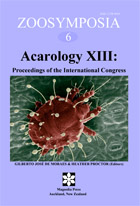Abstract
In a mutualistic relation between a potter wasp, Allodynerus delphinalis (Giraud) (Hymenoptera: Vespidae), and its specific parasitic mite, Ensliniella parasitica Vitzthum (Winterschmidtiidae), behaviour of the mite guarding the wasp and attacking their common natural enemy, Melittobia acasta (Walker) (Hymenoptera: Eulophidae), was examined.While mite attacks to M. acasta occurred by accidental physical contact, the counterattack by the parasitoid occurred 24 h after both were released onto their mutual host. The two organisms fought until one of them died in our experimental arena, which the parasitoid could not escape from to avoid combat. It was not possible to determine what the behaviour of the parasitoid would be had it been able to escape. Mite phoretic behaviour was also examined to understand the mechanism by which both the host wasp and the mite could reap reciprocal benefits from the presence of acarinaria on the wasp. The results suggested that the newly emerged host wasp might have an attractant to collect the necessary number of mites in an acarinarium, which would later function as guards of its offspring, given that around 46% of mite deutonymphs were able to migrate into one of the acarinaria within only 10 min after they were put together in an experimental arena. To more fully understand the strategy of each organism involved in this mutualism, further observation on their behaviour is needed.

